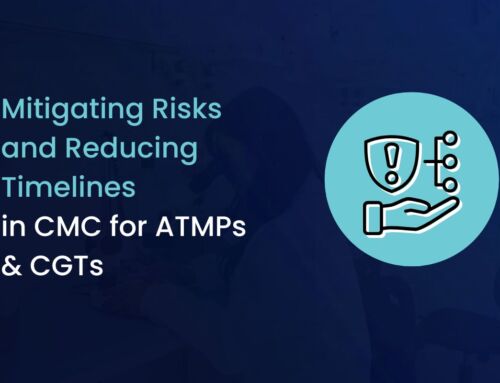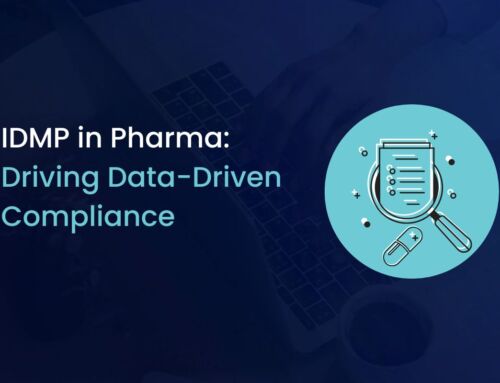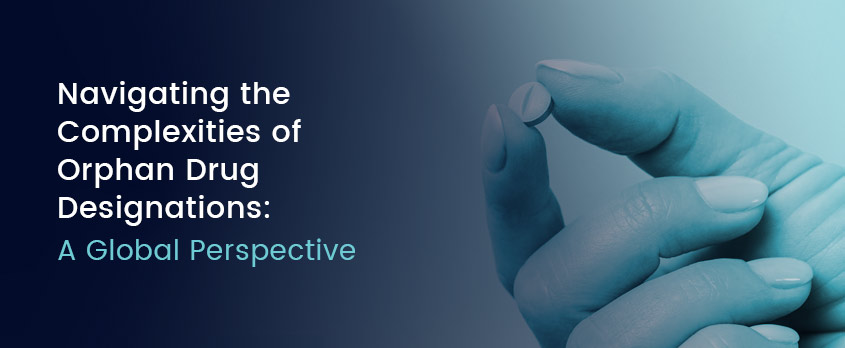
Navigating the Complexities of Orphan Drug Designations: A Global Perspective
Part 4 of a 4-part series on Regulatory Frameworks, check out part 1 here about Regional Differences of Regulatory Frameworks for Pharmaceutical Approvals, Part 2 here comparing US, EU, UK and Global Health Authorities, part 3 is about Pediatric Plans for Child Healthcare.
The development of Orphan drugs is crucial as these therapeutics provide life-saving treatments for rare diseases, often offering the only hope for patients and families battling conditions, mostly developed by small biotech and specialty pharmaceutical companies. In pharmaceutical development, orphan drugs are critical for treating rare diseases, also often referred to as orphan diseases.
Subtle differences exist among regions and countries, making it essential to understand these nuances. Celegence has extensive experience and deep expertise with global Orphan Drug requirements and frameworks. This blog, part 4 of a four-part series on regional considerations in regulatory compliance, focuses on the similarities and differences in orphan drug designations globally.
Importance of Orphan Drugs
Pharmaceutical success is often tied to volume and growth, recovering the high costs of development, testing, and clinical trials. This perception might suggest that addressing rare diseases, affecting a minority of the population (or niche populations), is less attractive, while the need for the development of orphan drugs for these rare conditions is vital. These specialty drugs not only meet the needs of those otherwise unattended but also demonstrate the healthcare industry’s commitment to providing solutions for all, regardless of the rarity of their conditions.
There are multiple ways to develop rare disease therapeutics. On one hand, companies focus on novel therapies (e.g. cell and gene therapies) targeting rare diseases and on the other hand there is a focus on repurposing existing drugs for rare diseases. Repurposing presents another significant opportunity within the orphan drug sector. Leveraging known safety profiles reduces development risk and investment, advancing rare disease treatment.
Currently, there are 7000 to 8000 known rare diseases worldwide, affecting about 300,000,000 people(1). This illustrates not only how costly the issue is from a healthcare perspective, but also how small the opportunity is for companies developing treatments for rare diseases.
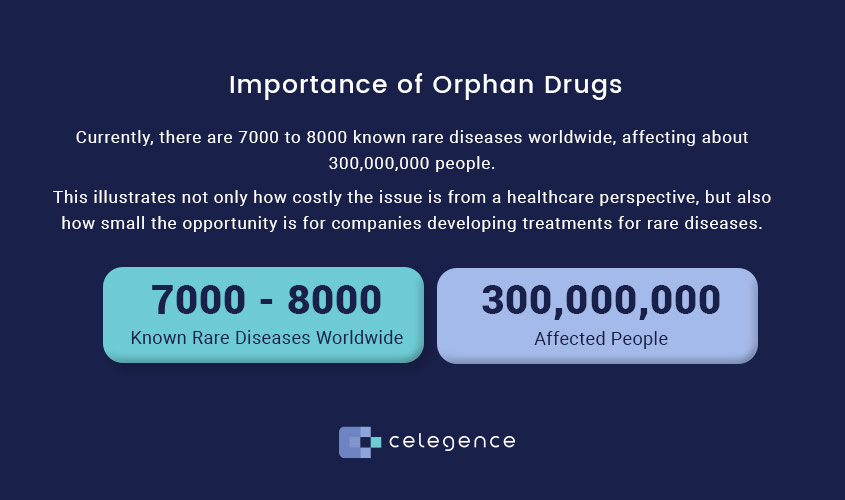
Common Incentives for Orphan Drugs
Despite limited commercial potential, developing these drugs offers hope to patients who might otherwise remain untreated. The cost burden is mitigated by incentives that encourage companies to pursue development and make treatments more widely available. These regulatory frameworks vary significantly across regions, requiring a comprehensive understanding for regulatory affairs professionals and pharmaceutical companies.
The US Orphan Drug Act
Globally, there are common themes in the incentives provided to offset costs and address rare diseases, driven by humanitarian and social impact considerations. For instance, in the US, the Orphan Drug Act of 1983 provides several incentives such as orphan drug tax credits, user fee waivers, and seven years of market exclusivity. The Food and Drug Administration (FDA) also offers a waiver from pediatric studies for orphan drugs, which is unique compared to other regions. The FDA has approved 600 orphan drugs between 1983 and 2020.
EMA Compensation for Orphan Drugs
In the EU, the European Medicines Agency (EMA) offers orphan designations for diseases affecting no more than five in 10,000 persons. The EU provides compensation for scientific and marketing authorization applications (MAA) and ten years of market exclusivity, requiring detailed documentation to navigate the regulatory process effectively. The Committee on Orphan Medicinal Products (COMP) handles all applications in the EU. EMA’s requirements are more stringent than those in the U.S., necessitating robust documentation and often expert assistance.
Nevertheless, in the EU there are about 2000 active orphan designations granted covering approximately 600 different orphan diseases. (Public Health – Union Register of medicinal products)
Asian Approach for Orphan Drugs
In Asia, various countries are increasingly supporting the development of treatments for rare diseases. For example, Japan’s Ministry of Health, Labour and Welfare (MHLW) provides incentives such as tax reductions, subsidies for development costs, and extensions of market exclusivity. Japan’s expedited review process speeds up the approval of drugs for rare diseases, supported by a robust patient registry system.
Similarly, South Korea offers a comprehensive support system for orphan drugs, including reduced fees for product registration, extended market exclusivity, and financial incentives for companies conducting clinical trials. China, through the China Food and Drug Administration (CFDA), includes provisions for orphan drug designation with benefits such as priority review and reduced registration fees. Taiwan’s Food and Drug Administration (TFDA) provides several incentives for orphan drugs, emphasizing international collaboration for clinical trials.
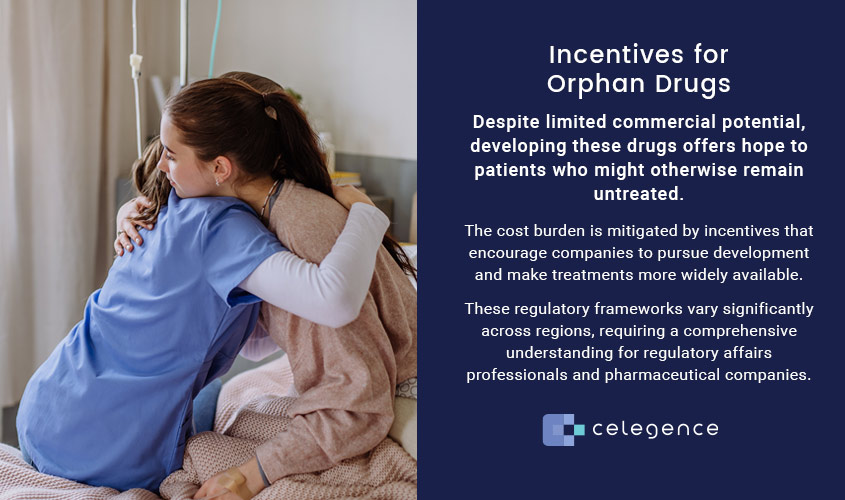
Differences in Regional Approaches
While there are similarities in the incentive structures, regional approaches differ notably. The U.S. provides a streamlined process that is particularly attractive to smaller biotech firms, emphasizing tax credits and accelerated approval pathways. In contrast, the EU looks for more comprehensive documentation and provides compensation for scientific advice, focusing on detailed regulatory requirements.
Post-Brexit, the UK is developing its own orphan drug regulatory framework, where the Orphan Drug designation can only be requested at the time of an MAA. This area requires careful monitoring to understand its implications for orphan drug development.
In Asia, countries like Japan and South Korea are adopting incentive programs similar to those in Europe and the U.S. Japan’s expedited review process, supported by a robust patient registry system, is a notable example. South Korea’s support system includes financial incentives and reduced fees, coordinated by the Korean Orphan Drug Center. China and Taiwan are also making significant strides, with China focusing on priority review and Taiwan emphasizing international collaboration for clinical trials.
India is gradually recognizing the importance of orphan drugs and has proposed frameworks for providing incentives. While specific legislation for orphan drugs is still developing, there have been moves to simplify approval processes and provide financial support for companies engaged in research for rare diseases. Despite these positive developments, challenges remain in Asia, including the need for a more unified approach to rare disease registries and patient data management. Increased awareness and patient advocacy could further shape the regulatory landscape.
Comparison table of regional differences and similarities for Orphan Drug development and designations
| Category | US | EU | UK | Japan |
|---|---|---|---|---|
| Number of People Affected | < 200,000 in the US | <5 in 10,000 in the EU | <5 in 10,000 in the UK | < 50,000 in Japan |
| Market Exclusivity | 7 years of market exclusivity | 10 years of market exclusivity | 10 years of market exclusivity | 10 years of market exclusivity |
| Government Incentives | Tax credits for clinical testing
Fee waivers |
On EU level protocol assistance and fee reductions. On national level tax incentives | Fee reductions for marketing authorization applications; Grants | Tax credits for clinical trials |
| Application Process | Orphan Drug Designation by FDA | Orphan Medicinal Product Designation by EMA | Orphan Drug Designation by MHRA | Orphan Drug Designation by PMDA |
| Regulatory Authority | FDA (Food and Drug Administration) | EMA (European Medicines Agency) | MHRA (Medicines and Healthcare products Regulatory Agency) | PMDA (Pharmaceuticals and Medical Devices Agency) |
| Potential Post-marketing Obligations | Post-market surveillance studies, treatment registries | Post-marketing studies, trteatment registries and annual reports | Post-marketing surveillance studies, treatment registries | Post-marketing studies and reports, treatment registries |
Examples: Advancements in Orphan Drug Development
There are many examples on the market of orphan drugs that now treat diseases that at one time had no cure. Let’s look at two of these:
Fast Track – WHIM Syndrome
The FDA’s recent approval this year of Xolremdi (Mavorixafor) for patients aged 12 and older with WHIM syndrome marks a significant advancement in the treatment of this rare genetic disease characterized by warts, hypogammaglobulinemia, infections, and myelokathexis (WHIM). This disease affects the body’s immune system, reducing the number of mature neutrophils and lymphocytes, which are critical for fighting infections. Prior to this approval, patients with WHIM syndrome faced recurrent, potentially life-threatening infections due to these deficiencies.
The approval of Xolremdi is particularly notable as it follows the FDA’s Fast Track, Rare Pediatric Disease, and Orphan Drug designations. These designations underline the drug’s importance in addressing unmet medical needs within both the orphan and pediatric populations.
This approval demonstrates the FDA’s commitment to advancing treatments for rare diseases, facilitated by programs that expedite development and review processes for drugs targeting underserved medical conditions. For patients with WHIM syndrome, and more broadly for those affected by rare pediatric diseases, this approval represents hope and a compelling case for ongoing efforts to provide more targeted and effective treatments.
Genetic Disease – Cystic Fibrosis
Another notable example of successful orphan drug development is the case of Ivacaftor (Kalydeco), developed by Vertex Pharmaceuticals for the treatment of cystic fibrosis. Cystic fibrosis is a rare, life-threatening genetic disease that affects the respiratory and digestive systems of approximately 70,000 people worldwide.
The breakthrough came when researchers identified that a small subset of cystic fibrosis patients had a specific genetic mutation. Ivacaftor targets this mutation, which affects only about 4-5% of the cystic fibrosis population, but the drug’s impact on these patients is profound. It significantly improves lung function and other key markers of the disease by enhancing the protein function impaired by the mutation.
Approved by the FDA in 2012, Ivacaftor was one of the first drugs to treat the underlying cause of cystic fibrosis rather than its symptoms. Expanded approval was given in 2017 by the FDA. In 2018, EMA granted orphan designation. The drug development and subsequent success showcased the potential for orphan drugs to provide highly effective treatments for patients with specific rare diseases, leading to improved quality of life and life expectancy. This case is often cited as an exemplary model of precision medicine in orphan drug development.
Orphan Drug Development Summary
The primary challenge in orphan drug development is the small market size for each product, which can limit profitability and deter investment. However, regulatory incentives like orphan product grants, tax credits, and accelerated approval pathways are designed to mitigate these issues. Companies, particularly smaller ones, should capitalize on these incentives.
Understanding the global regulatory requirements for orphan drugs is crucial for pharmaceutical companies. By navigating these complexities and leveraging available incentives, companies can make significant strides in developing treatments for rare diseases, offering improved quality of life to patients worldwide.
Collaboration with experienced consultants or regulatory partners is vital for managing the complex documentation and application processes, especially in Europe with the makeup of different country requirements. The potential within orphan drug development is substantial, with thousands of orphan diseases yet to be thoroughly investigated.
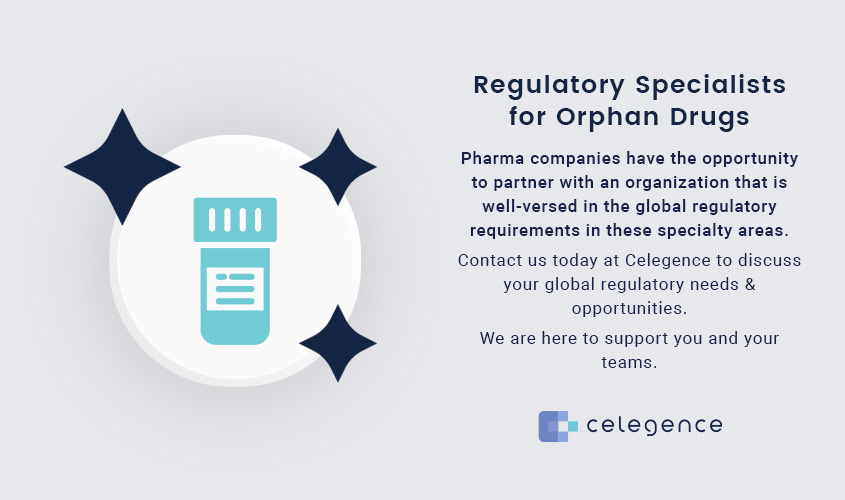
Regulatory Specialists for Orphan Drugs
Pharma companies have the opportunity to partner with an organization that is well-versed in the global regulatory requirements in these specialty areas. Contact us today at Celegence to discuss your global regulatory needs and opportunities. We are here to support you and your teams.
Footnotes: Rare Disease Day: https://www.rarediseaseday.org/
The Lancet Global Health: March 24, 2024 The Landscape for Rare Diseases in 2024
About The Author

This blog was authored by Maurice Bancsi, a Principal SME & Head of Regulatory Affairs at Celegence. His extensive background includes supporting pre-approval drugs and biologics for oncology, pulmonary, and cardiovascular indications. Maurice excels in developing regulatory strategies and leading cross-functional teams in health authority interactions. He has contributed to regulatory applications such as MAAs, CTAs, EU & US Orphan Drug Applications, PIPs, IPSPs, IND Annual Reports, and DSURs.
